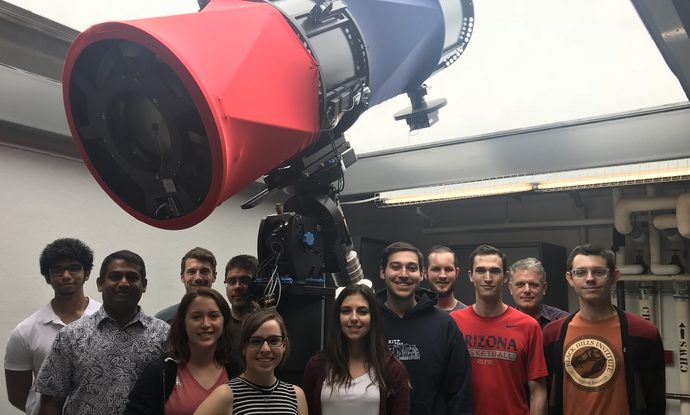Students are part of a drill that tests astronomers’ ability to respond to a highly unlikely — but not impossible — scenario: an asteroid on course to collide with Earth.
University of Arizona students recently took part in a NASA-led international exercise that used a real asteroid flyby to test global planetary defense capabilities. The project was designed to exercise how astronomers’ efficiency in determining the orbit, rotation, shape, size and composition of an asteroid that could potentially impact the Earth. The campaign was led by Vishnu Reddy, assistant professor in the UA’s Lunar and Planetary Laboratory.
The exercise’s target was the asteroid 2012 TC4. The small asteroid — only 50 feet long and 25 feet wide — was on course to closely approach Earth. On Oct. 12, TC4 safely passed the planet, coming within 27,200 miles of the surface (that’s about 5,000 miles above the orbit of geostationary satellites). In the months before the flyby, astronomers from the U.S., Canada, Colombia, Germany, Israel, Italy, Japan, the Netherlands, Russia and South Africa tracked TC4 using ground- and space-based telescopes from around the world.
Planning for the so-called TC4 Observation Campaign started in April, under the sponsorship of NASA’s Planetary Defense Coordination Office. The exercise commenced in earnest in late July, when the European Southern Observatory’s Very Large Telescope spotted the asteroid. The finale was a close approach to Earth in mid-October.
Graduate and undergraduate students at the UA were given the opportunity to participate in the project as part of a class Reddy taught with Walt Harris, professor in the Department of Planetary Sciences.
Using observations collected during the campaign, scientists at NASA’s Jet Propulsion Laboratory, or JPL, were able to precisely calculate TC4’s orbit, predict its flyby distance on Oct. 12 and rule out the possibility of a collision between Earth and the asteroid.
RAPTORS Network Put to Use
A network of telescopes, including the student-built Rapid Astronomical Pointing Telescopes for Optical Reflectance Spectroscopy, or RAPTORS, housed on the UA campus, was used to study how fast TC4 rotates. Given that TC4 is small, astronomers expected it to be rotating fast. They were surprised to find that the object was not only spinning once every 12 minutes, it also was tumbling.
A team of UA undergraduate students from Reddy’s class observed the asteroid using RAPTORS.
“Observing using RAPTORS went beautifully,” said Collin Lewin, one of Reddy’s undergraduate students. “The opportunity to operate a telescope like RAPTORS is rare for undergraduates, so this was a valuable experience for many students.”
Finding out what TC4 is made of turned out to be more challenging. Is the asteroid rich in carbon, or does it consist of bright rocky materials? Infrared observations made with NASA’s Infrared Telescope Facility, or IRTF, at the Mauna Kea Observatory in Hawaii would allow scientists to identify the asteroid’s composition. On a trip funded by the Lunar and Planetary Laboratory’s external advisory board, graduate students from the UA traveled to Hawaii to perform the necessary observations.
The work done by Reddy’s students would allow NASA to know exactly what materials comprised which parts of the asteroid. Although they were able to collect some data before the asteroid’s close approach, adverse weather conditions and technical difficulties prevented Reddy’s graduate students at IRTF from taking observations during TC4’s flyby on Oct. 12.
“Something always goes wrong. You have to learn how to deal with it,” said Cassandra Lejoly, a doctoral student in Reddy’s class.
Others in Reddy’s class, such as doctoral student Ben Sharkey, noted that the experience was useful for students who were unsure of the direction in which they wished to take their careers.
“This experience gave them an idea of what observing takes. It might help those students decide if they want to have to deal with the difficulties that come with observing,” Sharkey said.
“Whether or not our graduate students are going to use telescopes in their professional careers, they are going to work with people who do,” said Timothy Swindle, director of the Lunar and Planetary Laboratory. “One of the important things in a graduate student’s education is learning about the tools that you use, and the tools used by the people you work with. This was one opportunity for them to see how a telescope really works.”
Rare Opportunity for Students
Most observing can be done remotely, as the telescopes can send data to computers far from the observatories.
“Learning how to use a telescope as complicated as IRTF is something that few people get to do in person,” said Teddy Kareta, a first-year doctoral student at LPL. Witnessing the inner workings of the telescope granted students such as Kareta a deeper understanding and respect for the instruments and the people who operate and repair them.
“No one expected the observing trip to be quite as tumultuous as it was, but the students learned that when trying to do great things, they will face setbacks along the way,” Swindle said.
Although the setbacks at IRTF threw a small wrench in the observation campaign, scientists at JPL were nevertheless able to determine what materials were present at the surface of the asteroid. Radar scattering properties of TC4 are consistent with a bright, rocky surface, similar to a particular class of meteorites that reflect 50 percent of light that hits them.
In addition to the observation campaign, NASA used this exercise to test communications between the many observers and also to test internal U.S. government messaging and communications up through the executive branch and across government agencies. Such would be necessary during an actual impact emergency.
“We demonstrated that we could organize a large, worldwide observing campaign on a short timeline, and communicate results efficiently,” Reddy said.
Source: UA News

































Leave a Comment
You must be logged in to post a comment.